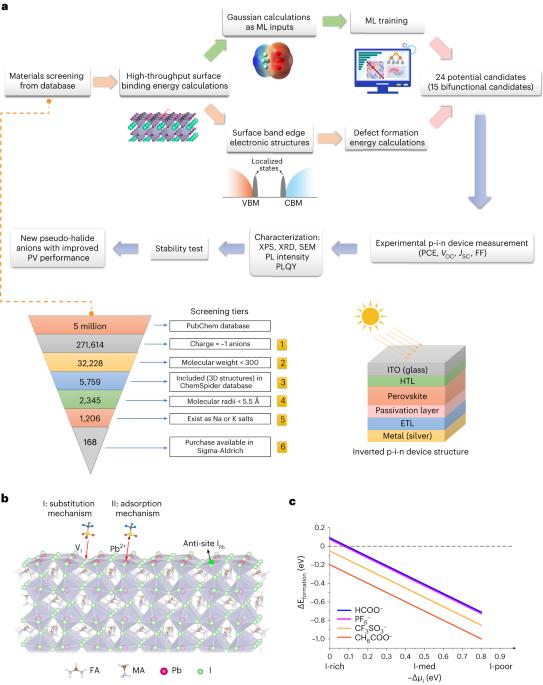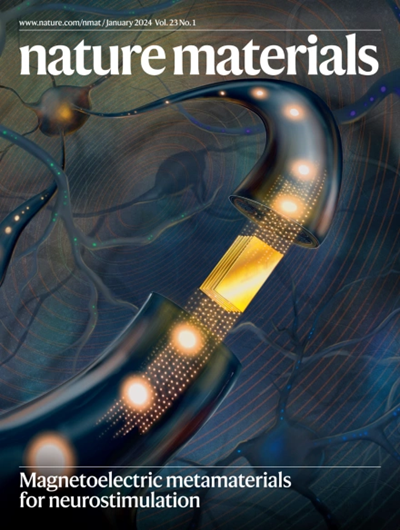Anion optimization for bifunctional surface passivation in perovskite solar cells
IF 38.5
1区 材料科学
Q1 CHEMISTRY, PHYSICAL
引用次数: 0
Abstract
Pseudo-halide (PH) anion engineering has emerged as a surface passivation strategy of interest for perovskite-based optoelectronics; but until now, PH anions have led to insufficient defect passivation and thus to undesired deep impurity states. The size of the chemical space of PH anions (>106 molecules) has so far limited attempts to explore the full family of candidate molecules. We created a machine learning workflow to speed up the discovery process using full-density functional theory calculations for training the model. The physics-informed machine learning model allowed us to pinpoint promising molecules with a head group that prevents lattice distortion and anti-site defect formation, and a tail group optimized for strong attachment to the surface. We identified 15 potential bifunctional PH anions with the ability to passivate both donors and acceptors, and through experimentation, discovered that sodium thioglycolate was the most effective passivant. This strategy resulted in a power-conversion efficiency of 24.56% with a high open-circuit voltage of 1.19 volts (24.04% National Renewable Energy Lab-certified quasi-steady-state) in inverted perovskite solar cells. Encapsulated devices maintained 96% of their initial power-conversion energy during 900 hours of one-sun operation at the maximum power point. Pseudo-halide anion engineering is an effective surface passivation strategy for perovskite-based optoelectronics but the large chemical space of molecules limits its potential. Here, the authors create a machine learning workflow to find optimized pseudo-halide anions, which are verified in devices with improved performances.

钙钛矿太阳能电池双功能表面钝化的阴离子优化。
伪卤化物(PH)阴离子工程已成为钙钛矿基光电子的一种感兴趣的表面钝化策略;但到目前为止,PH阴离子已经导致缺陷钝化不足并因此导致不希望的深杂质态。到目前为止,PH阴离子(>106个分子)的化学空间大小限制了探索整个候选分子家族的尝试。我们创建了一个机器学习工作流,使用全密度泛函理论计算来训练模型,以加快发现过程。基于物理的机器学习模型使我们能够通过一个防止晶格畸变和反位点缺陷形成的头组和一个优化的尾组来定位有前景的分子,以实现对表面的强附着。我们鉴定了15种潜在的具有钝化供体和受体能力的双功能PH阴离子,并通过实验发现巯基乙酸钠是最有效的钝化剂。该策略在1.19的高开路电压下实现了24.56%的功率转换效率 伏(24.04%国家可再生能源实验室认证的准稳态)。封装器件在900 在最大功率点下一个太阳运行的小时数。
本文章由计算机程序翻译,如有差异,请以英文原文为准。
求助全文
约1分钟内获得全文
求助全文
来源期刊

Nature Materials
工程技术-材料科学:综合
CiteScore
62.20
自引率
0.70%
发文量
221
审稿时长
3.2 months
期刊介绍:
Nature Materials is a monthly multi-disciplinary journal aimed at bringing together cutting-edge research across the entire spectrum of materials science and engineering. It covers all applied and fundamental aspects of the synthesis/processing, structure/composition, properties, and performance of materials. The journal recognizes that materials research has an increasing impact on classical disciplines such as physics, chemistry, and biology.
Additionally, Nature Materials provides a forum for the development of a common identity among materials scientists and encourages interdisciplinary collaboration. It takes an integrated and balanced approach to all areas of materials research, fostering the exchange of ideas between scientists involved in different disciplines.
Nature Materials is an invaluable resource for scientists in academia and industry who are active in discovering and developing materials and materials-related concepts. It offers engaging and informative papers of exceptional significance and quality, with the aim of influencing the development of society in the future.
 求助内容:
求助内容: 应助结果提醒方式:
应助结果提醒方式:


